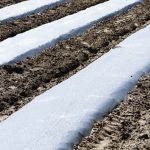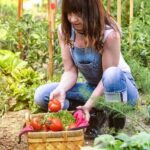Are you interested in growing your own fresh vegetables, but don’t have a lot of space for a traditional garden? Small container gardening vegetables could be the perfect solution for you.
By utilizing containers, even those with limited outdoor or indoor space can enjoy the benefits of growing their own produce. In this article, we will explore the various benefits and possibilities of small container gardening, from choosing the right containers to selecting the ideal vegetable varieties and creating the perfect growing environment.
Small container gardening offers several advantages, including accessibility, versatility, and convenience. Whether you live in an apartment with a small balcony or have a tiny backyard, you can still enjoy the satisfaction of growing your own vegetables. Additionally, container gardening allows you to easily move your plants to optimize sunlight and weather conditions, making it an excellent option for urban dwellers or those with limited outdoor space.
In this comprehensive guide, we will provide tips for selecting the right containers, essential tools and materials needed to get started with small container gardening, and advice on choosing the best vegetables for limited space. With this information at your fingertips, you’ll be well-equipped to embark on a successful small container gardening journey and enjoy delicious homegrown produce in no time.
Choosing the Right Containers
When it comes to small container gardening vegetables, selecting the right containers is crucial for the success of your garden. The size, material, and drainage of your containers can greatly impact the growth and health of your vegetables. Here are some tips for choosing the best containers for your small space garden:
1. Size: When it comes to small container gardening, size matters. It’s important to choose containers that are large enough to accommodate the root systems of your chosen vegetables. While smaller containers may be suitable for herbs and smaller plants, larger vegetables like tomatoes and peppers will require at least a 5-gallon container for optimal growth.
2. Material: The material of your containers can also make a difference in the overall health of your plants. Plastic, ceramic, or terracotta pots are popular choices for small container gardening vegetables. Each material has its own advantages and disadvantages, so consider factors such as durability, insulation, and weight when selecting the right material for your containers.
3. Drainage: Proper drainage is essential for the success of your small container garden. Without adequate drainage, excess water can build up and lead to root rot and other issues. When selecting containers, look for those with drainage holes at the bottom to allow excess water to escape. Additionally, consider using a layer of gravel or pebbles at the bottom of your containers to improve drainage.
By carefully considering the size, material, and drainage of your containers, you can set yourself up for success with small container gardening vegetables. Taking the time to select the right containers will ensure that your vegetables have the best possible environment to thrive in limited space environments.
Essential Tools and Materials
When embarking on small container gardening, having the right tools and materials is essential to set yourself up for success. These are some of the basic items you will need to get started with your small container gardening vegetables.
First and foremost, you will need containers suitable for growing vegetables. There are various options available, including plastic, terracotta, or fabric pots. It’s important to choose containers that have good drainage to prevent waterlogged soil, which can lead to root rot. Additionally, the size of the container is crucial as different vegetables have different root depths and spacing requirements.
In addition to containers, you will also need high-quality potting mix specifically formulated for vegetable gardening in containers. This type of soil is well-draining yet moisture-retentive and provides a good base for your vegetables to grow. Furthermore, consider investing in organic fertilizer to provide essential nutrients for your plants’ growth and development.
Other essential tools include a trowel or hand shovel for planting, a watering can or hose with gentle spray attachment for watering, and a pair of gardening gloves to protect your hands while working with the soil and plants.
| Essential Tools | Materials |
|---|---|
| Containers | Potting mix |
| Trowel | Organic fertilizer |
| Watering can/hose | Gardening gloves |
Ideal Vegetable Varieties for Small Containers
When it comes to small container gardening, choosing the right vegetables to grow is crucial. Not all vegetables are suited for limited space, so it’s important to select varieties that are well-suited for small containers. Here are some ideal vegetable varieties for small containers:
- Tomatoes: Cherry tomatoes and patio-sized tomato plants are perfect for small containers. They don’t take up much space and can be grown in pots on a patio or balcony.
- Peppers: Both sweet peppers and hot peppers can thrive in small containers. Look for compact pepper varieties that are well-suited for confined spaces.
- Lettuce: Leafy greens like lettuce and spinach are excellent choices for small container gardening. They don’t require a lot of room to grow and can be easily harvested as needed.
Other ideal vegetable varieties for small containers include radishes, carrots, and herbs like basil and cilantro. When selecting vegetables for your small container garden, consider the mature size of the plant and look for compact or dwarf varieties that will thrive in limited space.
By choosing the right vegetable varieties for your small container garden, you can maximize your growing space and enjoy a bountiful harvest, even in confined areas such as a balcony or small patio. With careful selection and proper care, you can create a thriving mini-garden filled with delicious homegrown vegetables.
Soil and Fertilizer
When it comes to small container gardening vegetables, creating the perfect growing medium is essential for the success of your plants. Unlike traditional garden beds, container gardens rely solely on the soil and fertilizer within the confines of the container. Therefore, it’s important to understand how to create an optimal environment for your vegetables to thrive.
The first step in creating the perfect growing medium for your small container garden is choosing the right soil. It’s crucial to select a high-quality potting mix that is specifically formulated for container gardening. These mixes are designed to provide adequate drainage and aeration, which are essential for healthy root development. Additionally, they are typically lightweight and free from pests and diseases.
In addition to selecting the right soil, incorporating fertilizer into your small container garden is also essential. Since containers have limited space and nutrients can be quickly depleted, regular fertilization is necessary to ensure a bountiful harvest. Consider using a slow-release fertilizer or organic options to provide a steady supply of nutrients to your vegetables throughout the growing season.
Be sure to follow the instructions on the product label to prevent over-fertilization, which can be harmful to your plants. By providing your small container garden with the proper soil and fertilizer, you’ll create an optimal growing medium that will support healthy plant growth and abundant vegetable production.
Watering and Maintenance
Consistent Watering
One of the most important aspects of maintaining a thriving small container gardening vegetables is consistent watering. Since containers tend to dry out more quickly than garden beds, it’s essential to check the soil moisture levels regularly and water when needed. Keep in mind that different vegetable varieties may have varying watering needs, so it’s crucial to tailor your watering schedule to the specific requirements of each plant.
Monitoring for Nutrient Deficiencies
In a small container gardening vegetables, it’s crucial to monitor your plants for any signs of nutrient deficiencies. Since the growing medium in containers can become depleted of nutrients more quickly than soil in traditional garden beds, it’s important to fertilize your vegetable plants regularly. Look out for symptoms such as yellowing leaves or stunted growth, as these could indicate a lack of essential nutrients like nitrogen, phosphorus, or potassium.
Pruning and Training
Regular maintenance tasks like pruning and training are also important for keeping your vegetable plants healthy and productive in small containers. Depending on the varieties you’re growing, you may need to prune off dead or diseased foliage, as well as train vining plants to grow upward instead of sprawling across the container. By keeping your plants well-maintained, you can ensure optimal airflow and sunlight penetration, which can help prevent issues like mold or mildew from developing.
By implementing these best practices for watering and maintenance, you can keep your small container gardening vegetables thriving throughout the growing season. With careful attention to the needs of your plants, you’ll be rewarded with a bountiful harvest of fresh, homegrown veggies from your compact container garden.
Pests and Diseases
Identifying Common Pests
Small container gardening can sometimes be vulnerable to pests that can harm your vegetable plants. Some common pests to watch out for include aphids, spider mites, snails, and slugs. These pests can damage the leaves and fruits of your vegetables if not controlled.
Natural Pest Control Methods
One of the advantages of small container gardening is that it allows for easier pest control. You can use natural methods to keep pests at bay, such as introducing beneficial insects like ladybugs or lacewings that feed on harmful pests. Additionally, you can make homemade sprays using ingredients like neem oil or garlic to deter common garden pests.
Diseases in Small Container Gardening
Recognizing Common Diseases
In addition to pests, diseases can also affect the health of your small container garden vegetables. Common diseases include powdery mildew, damping off, and blossom end rot. It is important to recognize the symptoms of these diseases early on in order to take appropriate action.
Disease Prevention Practices
To protect your small container garden from diseases, it’s crucial to practice good sanitation and proper watering techniques. Avoid overhead watering which can promote disease development and ensure adequate air circulation around your plants. Using disease-resistant vegetable varieties specifically suited for small containers can also help mitigate the risk of disease impacting your garden.
By being proactive in identifying and addressing potential pest and disease issues in your small container garden, you can safeguard the health and vitality of your vegetable plants, ultimately leading to a bountiful harvest for you to enjoy.
Harvesting and Enjoying
In conclusion, small container gardening vegetables can be a rewarding and enjoyable way to grow your own produce, even with limited space. By carefully selecting the right containers, tools, and materials, as well as choosing the ideal vegetable varieties for small spaces, you can create a thriving garden right on your balcony or patio. With the proper soil, fertilizer, and watering techniques, you can ensure that your vegetables will flourish in their small containers.
As you begin to harvest the fruits of your labor, it’s important to savor the experience of enjoying fresh, home-grown vegetables. Whether you’re picking a ripe tomato or harvesting a batch of crisp lettuce leaves, there’s nothing quite like the taste of produce that you’ve nurtured from seed to plate. The satisfaction of knowing exactly where your food comes from and the joy of watching your plants thrive is unparalleled.
Additionally, small container gardening vegetables can also be a great way to introduce children or beginners to gardening. The manageable size of container gardens allows for easy maintenance and accessibility, making it an ideal learning opportunity for those new to gardening.
Cultivating an appreciation for growing food at a young age can instill valuable skills and knowledge that will last a lifetime. In the end, small container gardening vegetables not only provide delicious and fresh produce but also offer an enriching experience for growers of all levels.
Frequently Asked Questions
What Vegetables Can You Grow in Small Pots?
You can grow a variety of vegetables in small pots, including cherry tomatoes, lettuce, spinach, radishes, and green onions. These vegetables are well-suited for containers due to their compact size and shallow root systems.
What Vegetables Grow Well Together in a Container?
Certain vegetables thrive when planted together in a container. For example, tomatoes, basil, and peppers make a great combination as they have similar growing requirements and complement each other’s growth. Additionally, carrots and radishes can be planted together as the radishes can help to aerate the soil for the carrots.
What Vegetables Can I Grow in 2 Gallon Pots?
In 2-gallon pots, you can successfully grow smaller vegetables such as herbs (basil, cilantro), small chili peppers, green onions, and certain varieties of lettuce or spinach. It’s important to consider the limited space and provide proper care and maintenance for these plants to thrive in smaller pots.

If you’re looking to get into vegetable gardening, or are just looking for some tips on how to make your current garden better, then you’ve come to the right place! My name is Ethel and I have been gardening for years. In this blog, I’m going to share with you some of my best tips on how to create a successful vegetable garden.





